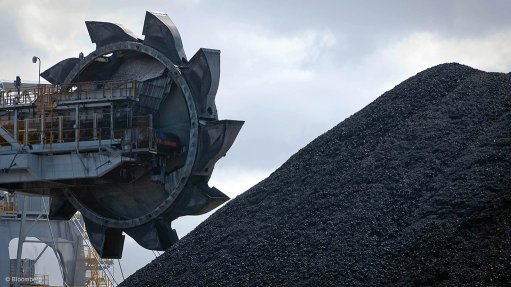
Photo by: Bloombeg
PERTH (miningweekly.com) – The Queensland Resources Council (QRC) on Wednesday said Queensland was well placed to supply India’s growing demand for coal, as the International Energy Agency (IEA) predicted an upsurge in coal demand.
In its 2015 World Energy Outlook, the IEA noted that developing Asia, a region in which India took over from China as the largest source of consumption growth, was the leading demand centre for every major element of the world's energy mix in 2040, including oil, gas, coal, renewables and nuclear.
The IEA predicted that, by 2020, India would be the world’s largest coal importer, overtaking Japan, the European Union and China.
“The forecast demand from India comes as no surprise and the report found that India would contribute one-quarter of global energy growth to 2040,” QRC CEO Michael Roche said on Wednesday.
“By 2040, Asia is projected to account for 4 t of every 5 t of coal consumed globally.”
Roche said this forecast was good news for Queensland and, in particular, for both the communities that already benefit from the resources sector across the state and those regions that are set to benefit.
“The sector already contributes A$64.8-billion to the state’s economy, or A$1 in A$5 and one in six jobs. These forecasts from the world’s most reputable agency mean that we are set to benefit from our natural resources well into the future,” Roche said.
“The forecasts also mean that we urgently need to fix our broken approvals system so we can bring on the new and expanded operations to tap into this huge market opportunity.
“That will mean more prosperity for Queenslanders in the form of jobs, business growth and royalties to fund government services, but will also help hundreds of millions of people across Asia and Africa who live without the luxury of electricity that we take for granted.”
The IEA suggested that Australia’s coal exports were set to grow by over one-third, with 45% of the growth being coking coal, which remained an essential ingredient in the making of steel.
“The good news for communities dependent on a thriving Bowen basin coking coal sector is that Australia is set to grab a two-thirds share of the entire global trade in coking coal. Overall, Australia is set to regain the position of the world’s leading coal exporter,” Roche said.
Nuclear’s share of world electricity generation was expected to rise slightly from 11% in 2013 to 12% in 2040, with nuclear-powered electricity generation forecast to increase by 86%.
“This forecast of strong growth in nuclear energy demonstrates conclusively that, with the right policy settings, Queensland does have a great opportunity to diversify its resource exports into uranium,” Roche said.
“The report shows that, despite the naysaying by green activists, Queensland is in pole position to supply the strong demand for energy resources over the coming decades.”
Meanwhile, Roche pointed out that the IEA report also confirmed that there was more opportunity to expand Queensland’s natural gas export sector, with demand for natural gas in Asia set to skyrocket by 160%.
The IEA forecast that production of natural gas could increase by 47% by 2040, with most of this growth coming from developing unconventional sources such as coal-seam and shale gas.
Australian Petroleum Production & Exploration Association CEO Malcolm Roberts said on Wednesday that Australia had benefited hugely from rising demand for liquefied natural gas (LNG) in the region.
“More than A$200-billion has been invested in LNG projects, creating thousands of jobs, export income and new revenue for the Commonwealth and state governments. Australia will be the world’s leading exporter of LNG by 2018,” Roberts said.
“The IEA forecasts that steady demand growth over the next 25 years will lead to another major wave of investment in gas production.
“The competition for investment will be intense. If Australia wishes to seize a share of this investment, businesses must continue to lift industry productivity while governments should focus on removing unnecessary regulatory and other costs.”